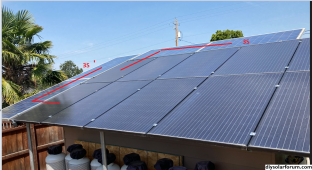OffGridInTheCity
Solar Wizard
One thing about poly vs mono is that poly is significantly larger/heavier than mono - maybe 20%. So if you have a space problem, it might be worth more $ for mono. Also, ploys are blueish and monos are blackish - and this might also affect a decision if you have wiggle room on the budget.
The size difference means that if you go one way on an array you it pushes you to expand with the same type within the same array due to physical dimensions.
Here you can see me grafting on 2 x mono + 4 x poly(s) to make additional 3s strings on a mono array. All panels are same wattage = 285w. Doesn't look nice and mounting was a challenge due to different sizes and thickness but this end of the array is in the back corner of the property and not very visible so I 'held my nose' and went with it.

I bought 40 x used polys from @SanTan Solar (ebay) at $70 each for my 'emergency stash' and didn't realize how different poly is from mono when purchasing. Up to that point all my panels were mono at $200 panel so I was blinded by $70. Poly is typically cheaper because it's larger/heavier and now I understand .
.
The size difference means that if you go one way on an array you it pushes you to expand with the same type within the same array due to physical dimensions.
Here you can see me grafting on 2 x mono + 4 x poly(s) to make additional 3s strings on a mono array. All panels are same wattage = 285w. Doesn't look nice and mounting was a challenge due to different sizes and thickness but this end of the array is in the back corner of the property and not very visible so I 'held my nose' and went with it.

I bought 40 x used polys from @SanTan Solar (ebay) at $70 each for my 'emergency stash' and didn't realize how different poly is from mono when purchasing. Up to that point all my panels were mono at $200 panel so I was blinded by $70. Poly is typically cheaper because it's larger/heavier and now I understand
Last edited:


